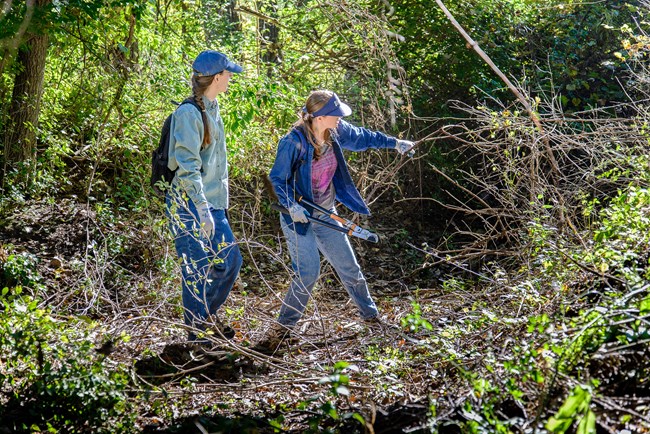Last updated: August 22, 2025
Article
Restoring Butterfly Habitat at Terra Vista

© Sue Simenc

NPS / Ted Toth
Terra Vista Natural Study Area is home to more than 20 types of butterflies. This national park research site in Valley View, Ohio is one of over a thousand places across the United States where scientists track butterfly populations. When invasive plants took over the meadow, a small army of volunteers began restoring this critical habitat.
Ohio’s Longest Butterfly Survey
The national park and its volunteers have monitored butterflies at Terra Vista since 1997. This research is a part of a long-term, statewide program run by the Cleveland Museum of Natural History and the Ohio Lepidopterists. Once a week from May to October, a team of citizen scientists walk the same path and record all the butterflies they see. Terra Vista is one of their three butterfly survey sites in the national park.
The volunteers identify and count all butterflies within 15 feet of the central transect line and submit their findings to a statewide database. Scientists at The Ohio State University use this data in their research and post their findings to the Ohio Lepidopterists website. Our Terra Vista team has been conducting the longest-running citizen science program in the national park, and the longest-running butterfly survey in the state.
Their research revealed a major drop in certain butterfly species from 1997 to 2009. Some of the steepest declines were 86% for the orange sulphur, 83% for the American copper, 79% for the clouded sulpher, 58% for the monarch, and 43% for the pearl crescent. These butterflies prefer the open meadow. Mourning cloak, little wood satyr, and common wood nymph—which live in and near the wooded areas—were less impacted. Although butterfly numbers naturally fluctuate year to year, it became clear that the plant life at Terra Vista was changing and it wasn't good for butterflies.

NPS / Ted Toth
Battling Autumn Olive
Nationally, many environmental problems contribute to the loss of butterflies including climate change, the use of pesticides, and efforts to control gypsy moths. At Terra Vista, the spread of autumn olive and other nonnative shrubs is a major factor. This silvery-leafed shrub originated in Asia and is considered invasive because it crowds out native species. Autumn olive can grow densely and producing a huge “bank” of seeds that linger in the soil. Every year, one plant produces 40,000 to 430,000 seeds.
Like all animals, butterflies need food to survive throughout their lives. Autumn olive only provides adult butterflies with pollen and nectar once a year, in the spring. In healthy meadows and forests, there are many different plants, providing flowers from spring to fall. To complicate matters, the caterpillars of each species eat leaves and require specific native plants on which to munch. The most famous relationship is between monarchs and milkweeds. When invasive plants crowd out these hosts, the adults have nowhere to lay their eggs.
Terra Vista is 266 acres of meadow and forest. The park has targeted about 35 acres of autumn olive for removal. Methods include applying an herbicide spray, cutting with hand tools and then spraying, and using controlled fire. To help with the enormity of this task, the park works with volunteers who attend invasive plant drop-in work sessions. While the process of removing autumn olive has been described as “never ending,” Biological Technician Tom Becker said that, at the end of a long day, it’s very uplifting to see an area once full of brush now open and clear.
Butterflies Return
Long-time Citizen Scientist Judy Hirschman reported that most types of butterflies have returned to Terra Vista. She explained that orange sulphurs are among the first to appear in April and linger to September. Pearl crescents, American coppers, and wood satyrs show up in May and stay into the summer. By June, there are viceroys. By July, you can see monarchs and great spangled fritillarys. Like birds, each butterfly has its own habits and months when the adults are present. Retired Biologist Meg Plona, who supervised the butterfly team for years, commended all the volunteers. She noted that “a diversity of butterfly species still exists at Terra Vista due to efforts to manage the invasive plants, especially the autumn olive.” Scientists need at least 15 years of data in order to see trends emerge. From 1996 to 2016, Ohio had a 33% decrease in its butterflies, likely due to a complex mixture of problems. Having long-term studies at places such as Terra Vista helps us understand what is happening and find effective solutions.

NPS / Ted Toth
Visit Terra Vista
If you would like to , park at the trailhead, 11400 Tinkers Creek Road, between Canal Road and Valley View Village Church. It is marked by a bulletin board. Hike up the gravel service road to the entrance sign. There is a fishing pond, a historic cemetery, and a loop trail.
Summer is the best time to see butterflies. We also recommend the third week in September when monarchs are in peak migration. The prime viewing spot is about halfway around on the loop trail. Butterflies are most active on sunny afternoons when the temperature is above 70 degrees. To get a closer look, bring a camera or binoculars.
Tags
- cuyahoga valley national park
- biodiversity
- butterfly
- butterflies
- pollinator
- invasive plants
- autumn olive
- exotic & invasive species
- invasive species
- resource management
- natural resource management
- research
- park science
- science
- field study
- monitoring
- recovery
- environmental
- conservation partnerships
- volunteer
- volunteers
- citizen science
- community science
- ohio
- midwest
- partnerships
